Introducing Sustainability into the Lab

Introducing Sustainability into the Lab
By Casey Nguyen, Green Labs Intern | March 16, 2021
UCI has made great strides in upholding its reputation as a sustainable campus. With its LEED Platinum buildings, sustainable transportation initiatives, and sustainable food practices, the importance of incorporating sustainability into research laboratories can easily be forgotten. UCI Green Labs show how simple green habits in the lab can make a significant contribution to achieving UCI’s sustainability goals.
By encouraging behavioral changes, the program demonstrates that it doesn’t take a lot of time, effort, or money to go green. In fact, many of the actions are similar to what one may do outside of research, such as turning off electronics and recycling, emphasizing that sustainability doesn’t have to end when one enters the lab. Here are a few ways Green Labs is introducing sustainability into UCI’s research laboratories.
Energy
Research labs consume over two-thirds of total campus energy. A large part of that energy consumption comes from laboratory equipment being in constant use and always plugged into an outlet. Something as simple as shutting the sash of a fume hood can save the equivalent to the combined amount of energy used on average by two homes and two cars in California in a given year. UCI Green Labs distributes “Shut the Sash” signs to remind lab members and inform them of the difference they’ll be making by shutting the sash (see below).
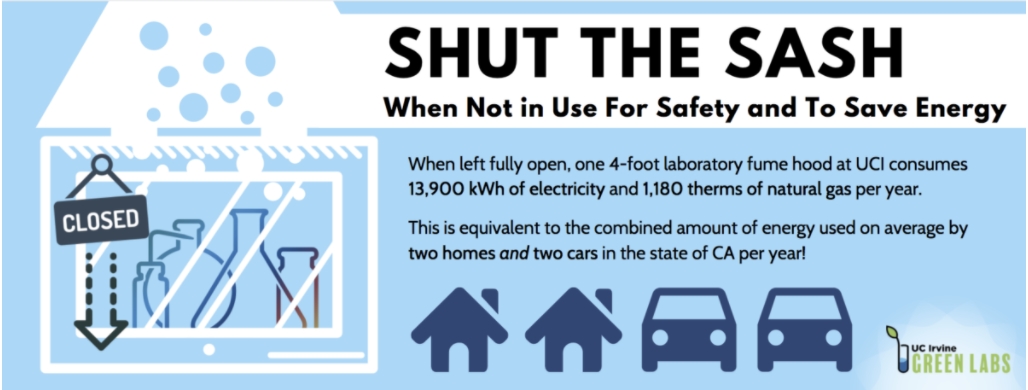
As shown below, other various equipment, such as incubators, centrifuges, and thermocyclers, can be marked with reminder labels to advise members of when the equipment item should be turned off, left on, or to ask before turning off.

When campus research laboratories are using over 66% of total campus energy, simple energy efficiency behavior helps contribute to UCI’s goal of reaching carbon neutrality by 2025.
Waste
Labs generate a lot of waste. According to My Green Lab, it's estimated that every year plastic waste alone from laboratories covers an area 23-times the size of Manhattan. Adhering to UCI’s priority of reducing, reusing, and recycling, Green Labs encourages researchers to minimize the use of disposable items and to donate and purchase from Peter’s Exchange. When it comes to recycling, the program provides several tools and resources to help educate on proper laboratory recycling. Examples of these tools and resources include the following:
- Recycling signs designed specifically for commonly-used laboratory items:
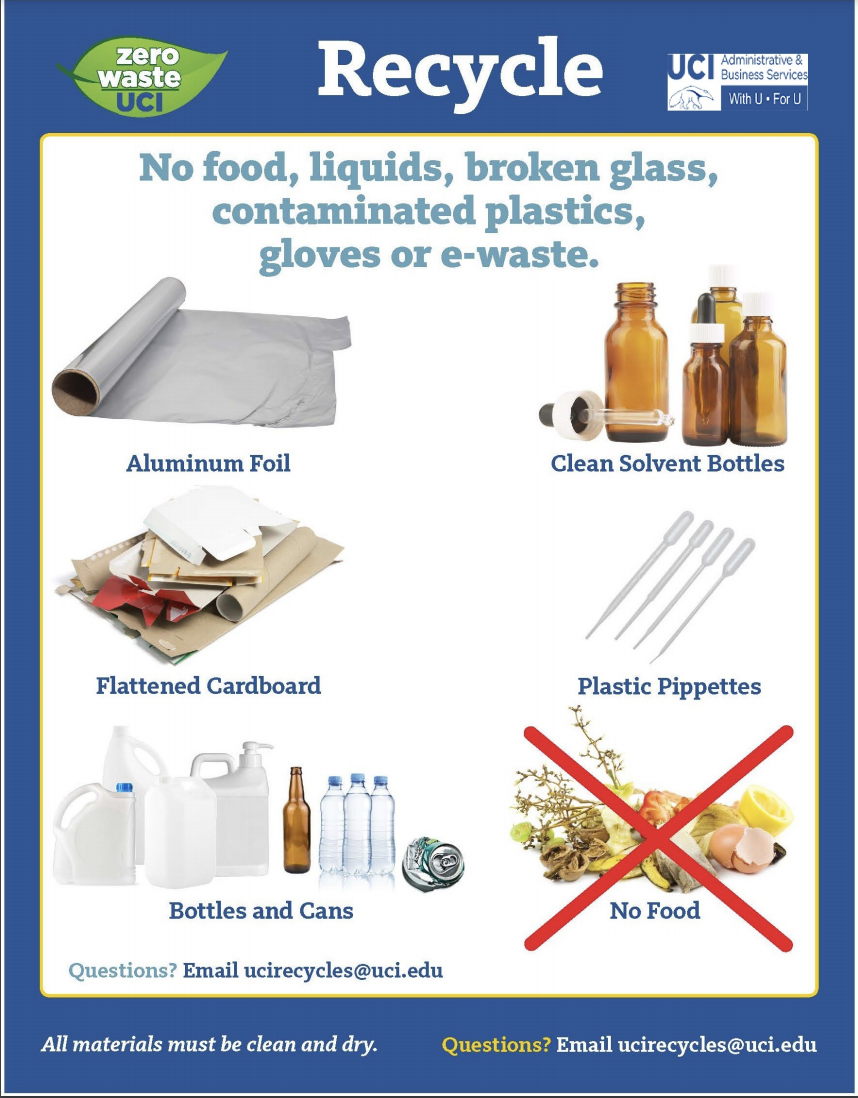
- Styrofoam bin recycling locations on the main campus:
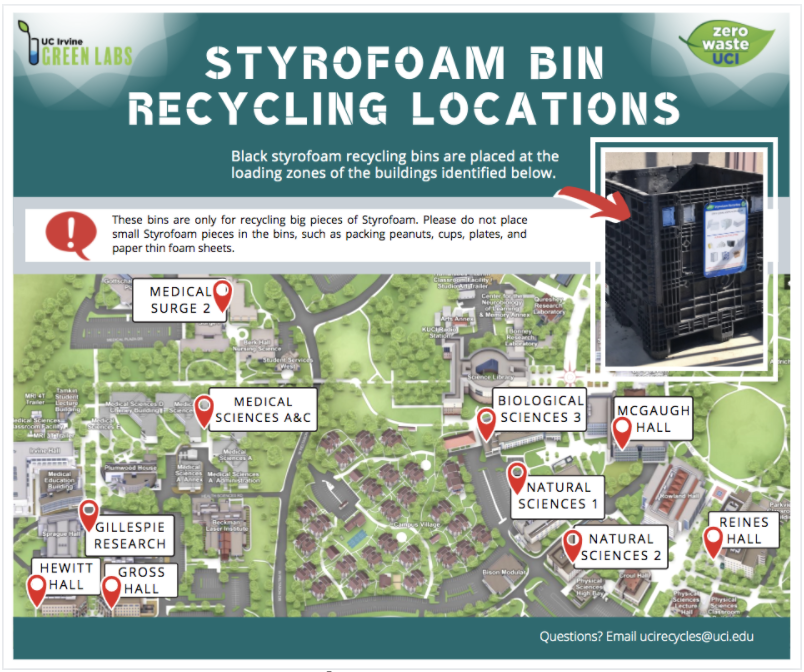
Raising awareness to labs on alternative waste disposal can cause less waste going into landfills, bringing UCI one step closer to being zero waste.
Water
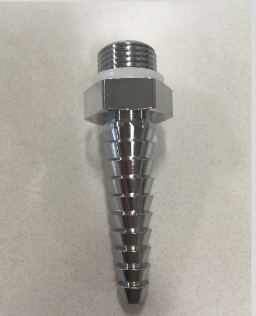 Autoclaves, DI water, and cage washers are just some of the water intensive users found in a lab. Through a Pepsi Co. grant, 425 flow restrictors were installed in five research buildings and have now become the campus standard for all new laboratory buildings. As shown, these flow restrictors reduce water flow from 2 gallons per minute (GPM) to 0.74 GPM, greatly lowering water usage and aiding UCI’s target of decreasing potable water consumption by 36 percent by 2025.
Autoclaves, DI water, and cage washers are just some of the water intensive users found in a lab. Through a Pepsi Co. grant, 425 flow restrictors were installed in five research buildings and have now become the campus standard for all new laboratory buildings. As shown, these flow restrictors reduce water flow from 2 gallons per minute (GPM) to 0.74 GPM, greatly lowering water usage and aiding UCI’s target of decreasing potable water consumption by 36 percent by 2025.
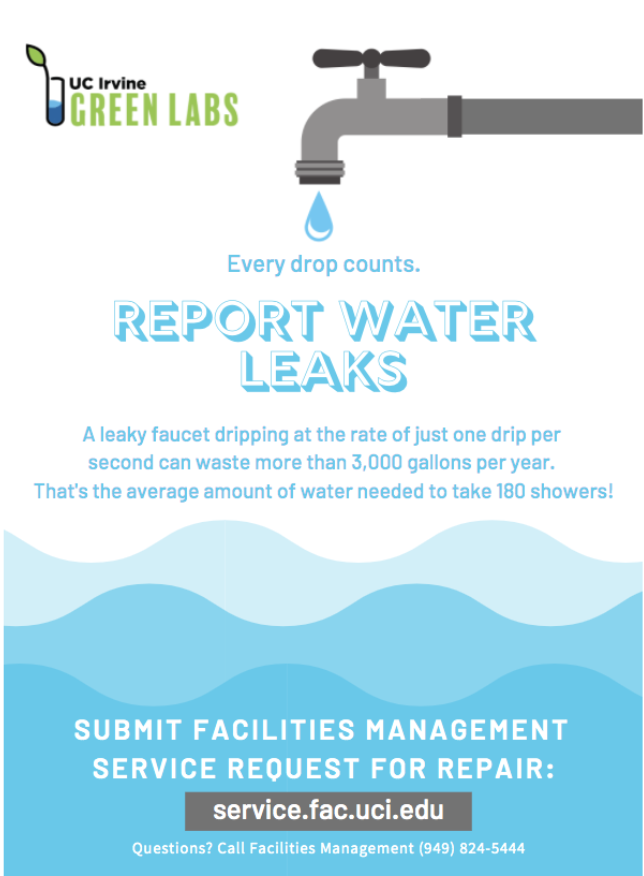 Green Labs also distributes a “Report Water Leaks” sign to be hung near laboratory sinks. This is a helpful, visual reminder to report leaks when noticed. If a leak is left unrepaired, it can result in unnecessary water usage - wasting more than 3,000 gallons of water per year.
Green Labs also distributes a “Report Water Leaks” sign to be hung near laboratory sinks. This is a helpful, visual reminder to report leaks when noticed. If a leak is left unrepaired, it can result in unnecessary water usage - wasting more than 3,000 gallons of water per year.
Green Labs strives to empower all researchers to implement more sustainable behavior into their lab, and more than often, labs learn that by making simple adjustments to their daily practices, they can easily strengthen the sustainability culture of their labs and aid UCI in meeting its sustainability goals and targets. To learn more about the UCI Green Labs program and to sign-up, click here.